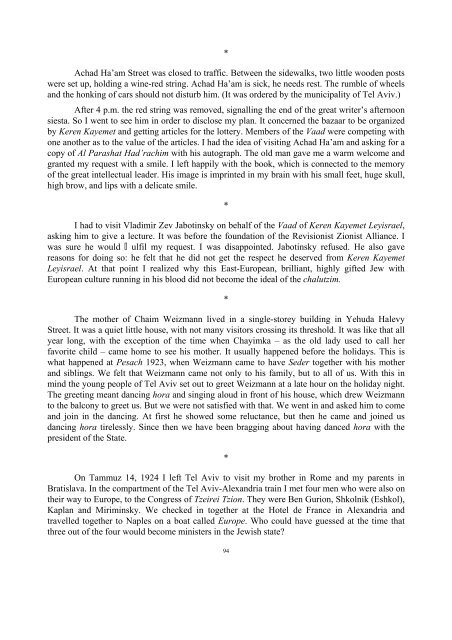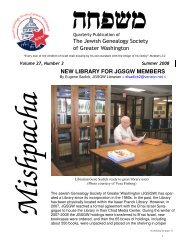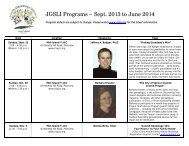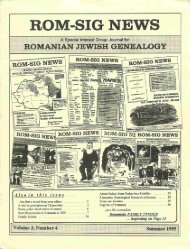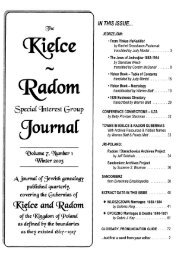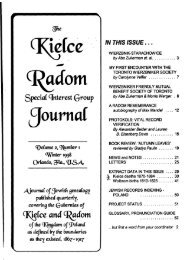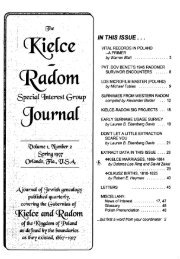THE MEMORIAL BOOK OF PÁPA JEWRY - JewishGen
THE MEMORIAL BOOK OF PÁPA JEWRY - JewishGen
THE MEMORIAL BOOK OF PÁPA JEWRY - JewishGen
You also want an ePaper? Increase the reach of your titles
YUMPU automatically turns print PDFs into web optimized ePapers that Google loves.
*<br />
Achad Ha’am Street was closed to traffic. Between the sidewalks, two little wooden posts<br />
were set up, holding a wine-red string. Achad Ha’am is sick, he needs rest. The rumble of wheels<br />
and the honking of cars should not disturb him. (It was ordered by the municipality of Tel Aviv.)<br />
After 4 p.m. the red string was removed, signalling the end of the great writer’s afternoon<br />
siesta. So I went to see him in order to disclose my plan. It concerned the bazaar to be organized<br />
by Keren Kayemet and getting articles for the lottery. Members of the Vaad were competing with<br />
one another as to the value of the articles. I had the idea of visiting Achad Ha’am and asking for a<br />
copy of Al Parashat Had’rachim with his autograph. The old man gave me a warm welcome and<br />
granted my request with a smile. I left happily with the book, which is connected to the memory<br />
of the great intellectual leader. His image is imprinted in my brain with his small feet, huge skull,<br />
high brow, and lips with a delicate smile.<br />
*<br />
I had to visit Vladimir Zev Jabotinsky on behalf of the Vaad of Keren Kayemet Leyisrael,<br />
asking him to give a lecture. It was before the foundation of the Revisionist Zionist Alliance. I<br />
was sure he would ulfil my request. I was disappointed. Jabotinsky refused. He also gave<br />
reasons for doing so: he felt that he did not get the respect he deserved from Keren Kayemet<br />
Leyisrael. At that point I realized why this East-European, brilliant, highly gifted Jew with<br />
European culture running in his blood did not become the ideal of the chalutzim.<br />
*<br />
The mother of Chaim Weizmann lived in a single-storey building in Yehuda Halevy<br />
Street. It was a quiet little house, with not many visitors crossing its threshold. It was like that all<br />
year long, with the exception of the time when Chayimka – as the old lady used to call her<br />
favorite child – came home to see his mother. It usually happened before the holidays. This is<br />
what happened at Pesach 1923, when Weizmann came to have Seder together with his mother<br />
and siblings. We felt that Weizmann came not only to his family, but to all of us. With this in<br />
mind the young people of Tel Aviv set out to greet Weizmann at a late hour on the holiday night.<br />
The greeting meant dancing hora and singing aloud in front of his house, which drew Weizmann<br />
to the balcony to greet us. But we were not satisfied with that. We went in and asked him to come<br />
and join in the dancing. At first he showed some reluctance, but then he came and joined us<br />
dancing hora tirelessly. Since then we have been bragging about having danced hora with the<br />
president of the State.<br />
*<br />
On Tammuz 14, 1924 I left Tel Aviv to visit my brother in Rome and my parents in<br />
Bratislava. In the compartment of the Tel Aviv-Alexandria train I met four men who were also on<br />
their way to Europe, to the Congress of Tzeirei Tzion. They were Ben Gurion, Shkolnik (Eshkol),<br />
Kaplan and Miriminsky. We checked in together at the Hotel de France in Alexandria and<br />
travelled together to Naples on a boat called Europe. Who could have guessed at the time that<br />
three out of the four would become ministers in the Jewish state?<br />
94


